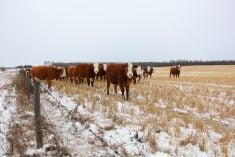Castration, and to a lesser extent dehorning, are routine and necessary procedures on cattle farms, ranches and feedlots across the nation. These stressful events deliver varying levels of concentrated pain to their recipients which fade over time but in doing so, also create extended ripples of influences throughout an animal’s life.
Dr. Michael Jelinski of Veterinary Agri-Health Services Ltd. says first and foremost, many recent studies prove drugs such as meloxicam mitigate pain.
“This is no longer a question,” he says. “Pain mitigation helps our industry defend to the consumer exactly what we’re doing, which is critical. They’re ultimately the judges of our product.”
Read Also

The Canadian Cattle Association’s international advocacy efforts
Global ag policies affect Canadian food policy, so the Canadian Cattle Association participates in international and domestic forums
Initial research
Twelve years ago, Jelinski was involved in trials with Dr. Merle Olsen from Solvet, a Canadian veterinary pharmaceutical company, and the Alberta Livestock and Meat Agency. Their goal was to compile the original licensing studies focused on implementing an oral pain product for castration banding approval in Canada. These efforts produced two-fold results, including the desired oral product’s sanction, and the first label approval for band castration pain relief.
A more recent study headed up by Jelinski’s colleague, Dr. Elizabeth Homerosky, asked whether anti-inflammatories such as meloxicam used on cattle at arrival interfere with immune responses. Merck Animal Health and the American Association of Bovine Practitioners provided funding to address the question.
READ MORE: Canadian company to launch anaesthetic-infused castration bands
Two-hundred and sixty calves were vaccinated upon arriving in the feedlot with Merck respiratory vaccines. Half also received an oral meloxicam dose. Over 28 days, antibody titres were assessed through the examination of core antigens: IBR, BVD, BRSV and PI3.
No notable differences in immune responses were seen, although the trial wasn’t deemed large enough to determine whether meloxicam affected respiratory rates.
Addressing respiratory relapse
Research completed by Feedlot Health Management and funded by Vetoquinol in multiple southern Alberta feedlots, trialed three groups of calves being treated for bovine respiratory disease (BRD) for the first time, using the following treatments:
- FEN — florfenicol (Fenicyl) alone
- FENMEX — florfenicol plus meloxicam oral suspension
- RES — florfenicol and flunixin-meglumine combination (Banamine)
Sick calves received one of the three options and relapse rates were measured.
A slight three to four per cent reduction was seen in the FENMEX group but the authors concluded it wasn’t economically significant. Considering the meloxicam cost, or in the RES case, the additional cost of the Banamine component, the best economics-based answer was using florfenicol alone.
“These types of trials are worthwhile,” Jelinski says. “Although the Vetoquinol study may not have shown an economic advantage to using meloxicam in combination with an antibiotic for initial BRD therapy, it did result in a small reduction in subsequent antibiotic use which is a positive outcome. It also opens further questions that need to be examined.”
U.S. study
A Kansas State University study headed by Dr. Hans Coetzee involving 258 male calves (bulls and steers) gave an oral dose of meloxicam to half the group and placebos to the other half 24 hours before castration. Weights and indications of BRD were monitored for 28 days. The group receiving meloxicam was determined to be nearly 50 per cent less likely to develop BRD compared with placebo-treated controls.
“An important distinction is a view of what else is occurring concurrently at the time of the meloxicam administration,” Jelinski says. “Coetzee’s study shows clear evidence of a reduction of respiratory disease for those provided meloxicam before experiencing a traumatic event like castration. This makes sense because of the immunosuppressive effects of pain and its management appears to dampen this effect, thereby lowering the BRD risk.”
Jelinski hopes to see similar studies expanded through finishing and slaughter, to evaluate performance factors such as average daily gain, feed conversion and carcass value alongside BRD incidences.
Many meloxicam studies confirm treated groups gain more weight during the first 30-60 days when used for procedures such as castrations and dehorning. But much of this advantage is lost over an entire feeding period. Considering compensatory gains, it’s difficult to prove economic benefit.
“We’re unsure whether profitability will always be higher, but it’s a hard sell to society to proclaim we’re not using pain mitigation because it doesn’t pay financially. Those optics are not positive for the industry, so we need to strike a balance between animal welfare and economics.”

Pain management on-ranch
On a positive note, Jelinski is impressed with how quickly the industry adopted pain management once the competitively priced oral meloxicam was introduced.
“A question was whether producers would use it as it was an additional input cost,” he says. “Most in the industry were surprised at its rather rapid adoption.”
Admittedly, some of this use and acceptance was driven by the phased-in code of practice starting in 2016 requiring animals over nine months of age to receive pain management for castration. In 2018 the code was amended to those over six months of age, but many producers willingly adopted the practice during branding sessions and other similar events. Other factors driving its adoption include its low cost and verified data.
Jelinski believes pain management studies and their longer-term implications will continue to evolve but would like to see another molecule come down the pipeline. Current research aimed at cats and dogs is exciting but also yields overly expensive drugs. Scaling production so that such products would be cost-effective for cattle producers is still a distant goal.
“The Holy Grail would be a longer-acting product which shows strong efficacy and safety for use in food animals,” he says. “I always say pain management is a journey, not a destination. I’m certain these improvements will be coming.”
Bruce Derksen lives, works and writes in Lacombe, Alta. He has 30 years of experience as a hands-on participant in numerous branches of the western Canadian livestock industry.
















